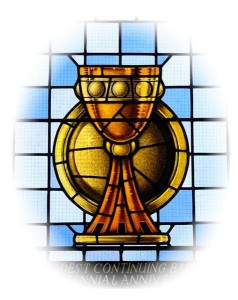 On the night of the 17th/18th May 1536, while the carpenters built her scaffold within the grounds of the Tower of London, Anne prepared herself for her execution which was scheduled for 9am on the 18th. At 2am, her almoner, John Skip, arrived to pray with her and she was still in prayer when Archbishop Cranmer arrived just after dawn to hear her final confession and celebrate the Mass.
On the night of the 17th/18th May 1536, while the carpenters built her scaffold within the grounds of the Tower of London, Anne prepared herself for her execution which was scheduled for 9am on the 18th. At 2am, her almoner, John Skip, arrived to pray with her and she was still in prayer when Archbishop Cranmer arrived just after dawn to hear her final confession and celebrate the Mass.
The Sacrament
As Anne Boleyn thought she would be dying in just a few hours, she wanted the Sacrament and she asked for Sir William Kingston, the Constable of the Tower, to be present. As Anne took the sacrament she swore on the sacrament twice, before and after receiving the body of Christ, that she had not been unfaithful to the King, as Chapuys reported in a letter to Charles V:-
“The lady who had charge of her has sent to tell me in great secresy that the Concubine, before and after receiving the sacrament, affirmed to her, on the damnation of her soul, that she had never been unfaithful to the King.”1
Anne obviously wanted Kingston to pass this information on to Cromwell and he did:-
“This morning she sent for me, that I might be with her at such time as she received the good Lord, to the intent I should her speak as touching her innocency alway to be clear.”2
It changed nothing. Anne could have sworn her innocence until she was blue in the face but the swordsman of Calais was on his way, the scaffold was being erected and her marriage had been annulled. Anne had been abandoned by Henry VIII and she was to suffer death.
Eric Ives writes of how Anne made arrangements for the distribution of the £20 that the King had given her to give to the people as alms, and then she waited for 9am, the moment she thought she would take her final walk. She went back to her prayers.
Not Today
When nothing happened at 9am, Anne sent for Kingston. She had heard that her execution had been postponed until noon:-
“Master Kingston, I hear say I shall not die afore noon, and I am very sorry there fore, for I thought to be dead by his time and past my pain.”3
Ives points out that Kingston knew full well that Anne was not being executed that day as he had received orders from Cromwell to clear the Tower of foreigners, perhaps so that foreign diplomats could not send home sympathetic reports of Anne’s execution. Kingston kept Anne in the dark for a while longer and tried to comfort her by explaining that her execution would not be painful and that the blow was “so subtle”. To this, Anne replied in her rather black humour, “I heard say the executioner was very good, and I have a little neck” and then she put her hands around her throat and laughed.4
Anne’s black humour in those dark hours showed through as she joked with her ladies that the people would be able to give her the nickname “la Royne Anne Sans Tete” or Queen Anne Lackhead, and then she laughed5. Those hours of waiting and not knowing what was going on must have been pure hell for Anne as she had prepared herself to die that day. She was finally put out of her misery when noon passed and Kingston informed her that her execution had been postponed until the next day, the 19th. According to Chapuys, “when the command came to put off the execution till today [19th], she appeared very sorry, praying the Captain of the Tower that for the honor of God he would beg the King that, since she was in good state and disposed for death, she might be dispatched immediately”6 and Lanceleot de Carles has her adding that it was “not that she desired death, but she had thought herself prepared to die, and feared that the delay might weaken her resolve”7, but there was nothing that Kingston could do to ease Anne’s suffering. All Anne could do was return to prayer and wait.
Notes and Sources
- L&P x.908
- Quoted in Weir p251
- Wolsey, ed. Singer, p460-1, quoted in Ives
- L&P x.910
- Quoted in Weir p255
- L&P x.908
- Lancelot de Carles, cited in Weir p254
